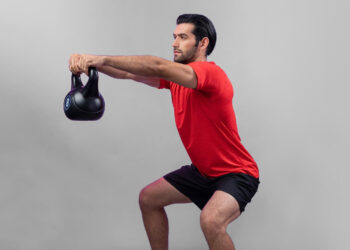Situps Calories Burned Calculator
Depending on your weight, on average you’ll burn 9.5 calories for each minute you do sit-ups, which equates to 572 calories per hour. This means that doing sit-ups regularly can burn a lot of calories which will help you stay in a caloric deficit and decrease your body fat.
Pairing sit-ups with other core exercises, cardio, and strength training will allow you to see great results in a short amount of time
Calories Burned with Home Exercises (Weight: 175lbs)
| MET | 15 mins. | 30 mins. | 45 mins. | 60 mins. | |
|---|---|---|---|---|---|
| Abs Exercises | 7 | 146 | 292 | 438 | 583 |
| Burpees | 8 | 167 | 333 | 500 | 667 |
| Jumping Rope | 8.8 | 183 | 367 | 550 | 733 |
| Squats | 5.5 | 115 | 229 | 344 | 458 |
| Jumping Jacks | 7.7 | 160 | 321 | 481 | 642 |
| Sit-Ups | 8 | 167 | 333 | 500 | 667 |
| Lunges | 4 | 83 | 167 | 250 | 333 |
| Kettlebells | 8 | 167 | 333 | 500 | 667 |
| Push-Ups | 3.8 | 79 | 158 | 238 | 317 |
| Rowing | 4.8 | 100 | 200 | 300 | 400 |
| Bridges | 3 | 63 | 125 | 188 | 250 |
| Deadlifting | 6 | 125 | 250 | 375 | 500 |
| Calisthenics - Vigorous | 8 | 167 | 333 | 500 | 667 |
How To Do Sit-ups
Sit-ups may seem like a very easy exercise to do since they don’t involve much equipment to get started with. This may be the case, but it’s important to have the right form when doing any type of sit-up.
Doing sit-ups step-by-step:
- Lie on the floor facing the ceiling with a slight bend in your knees and arms bent at the elbows and hands lightly touching your head by the ears
- Engage your core and lift your upper body so your right elbow touches your left knee
- Return to the start position then lift your upper body so your left elbow touches your right knee
- Return to the start position and repeat
This is how to do a basic sit-up, and we will get into sit-up variations that offer additional benefits and target different muscles in the core.
Sit-ups are a diverse exercise that comes with plenty of benefits if you do them consistently with the correct form. If you use the improper form when doing sit-ups, you put yourself at risk of injury which could cause you to spend weeks or months not being able to workout.
In fact, studies have shown that if you perform sit-ups without proper form, your chances of getting back pain and arching of the back increases significantly [1], which makes it even more important to learn the correct form of doing sit-ups before you get started.
Level Up Your Fitness: Join our 💪 strong community in Fitness Volt Newsletter. Get daily inspiration, expert-backed workouts, nutrition tips, the latest in strength sports, and the support you need to reach your goals. Subscribe for free!
Many people think that doing sit-ups will get you a six-pack right away. However, the only way to achieve six-pack abs is to reduce your body fat percentage on your overall physique, as it’s impossible to spot reduce certain parts of your body like your abs.
The best way to reduce body fat at a sustainable pace is to get on a balanced nutrition plan and a consistent strength training routine.
It’s also a great idea to alternate between steady-state cardio and HIIT training to target different areas of your body and to make sure you don’t plateau after doing the same exercise for long periods of time.
Benefits of Sit-ups
Sit-ups are a classic exercise that have been performed by people all across the world for centuries. Since you typically only need to use your body weight when doing regular sit-ups, there’s no additional equipment you need to get started.
Sit-ups work many different muscles, including:
- Rectus abdominis
- Transverse abdominis
- Obliques
- Hip flexors
- Chest
- Neck
In addition to working all these muscles, sit-ups also allow you to improve your posture by working your lower back and glute muscles. They also force you to have a greater range of motion compared to similar exercises like crunches and other static core exercises.
Performing sit-ups regularly not only tones your core and abdominal regions but also increases your muscle mass in these areas. Adding muscle is important if you want to lose body fat over time since the more muscle you have makes it easier to lose fat.
By strengthening the pelvis, lower back, and hips, sit-ups reduce the risk of back pain and lower back injuries. A 2010 study showed that including sit-ups in workouts produced positive results in preventing musculoskeletal injuries [2].
Some additional benefits from performing sit-ups include:
- Better balance and stability
- Increased flexibility
- Athletic performance
- Improved posture
How the Calculator Works
We use MET values to give you an estimate of the number of calories you can expect to burn doing sit-ups and other exercises.
What Are MET Values?
A MET value is a ratio between the working metabolic rate and the resting metabolic rate [3], which is the amount of energy you use relative to the duration of time spent doing the activity.
When a MET value is low, this tells you that the activity doesn’t involve expending much energy. For example, a MET value of 1 is equal to the number of calories you would burn at rest, and a MET value of 3 shows that you’d burn 3 times as many calories as you would at rest.
It’s important to know that the number of calories you burn is heavily dependent on your weight and the level of intensity you’re performing the exercise.
Formula
The formula that our sit-ups calculator uses to determine the number of calories burned per minute is (MET x bodyweight in Kg x 3.5) ÷ 200.
Examples
A person weighing 150 pounds will burn approximately 572 calories per hour from doing sit-ups. This activity has a MET of 8, which means that it burns 8 times as many calories as being at rest.
This is what the formula for calculating the calories burned while doing sit-ups will look like for a 150-pound individual at a MET value of 8.
- Calories burned (per minute) = (body weight in kg x MET x 5) ÷ 200
- Calories burned (per minute) = ( 68 x 8 x 5 ) ÷ 200
- Calories burned (per minute) = 5 calories x 60
- Calories burned (per hour) = 572 calories per hour
Sit-up Variations
Jackknife sit-up

As we mentioned earlier, there are plenty of different variations of sit-ups that you can try to target different muscles. One popular variation of the sit-up is the jackknife sit-up, which targets the iliopsoas and rectus abdominis and is more difficult to do than a regular sit-up.
Bicycle crunches
Bicycle crunches are another variation of sit-ups that you may have seen people perform in the gym. This variation targets the abdominals and obliques and is easy for beginners to perform. Check out this article to learn everything you need to know about bicycle crunches and how to do them with the right form.
Janda sit-up
The Janda sit-up is a more advanced variation of sit-ups that activates the muscles of the midsection. Also, posterior chain muscles like glutes, hamstrings, and hip flexors are also engaged when done properly.
The Janda sit-up is a very challenging exercise to do even for fit individuals. If you cannot perform one or more reps, start from the top of the sit-up and slowly lower yourself down.
Therefore, you’re only doing the eccentric or negative portion of the exercise but it’ll help to strengthen the muscles required to do the exercise.
Cable side crunch
The last variation we will discuss is the cable side crunch. This is a variation that targets the oblique muscles of the core.
When doing the side crunch, it’s important to stand up straight and not lean back. Standing at an angle to the pulley will ensure that you crunch down into the obliques for maximum muscle contraction.
The Bottom Line
Sit-ups are a diverse exercise with plenty of variations you can do to target different muscle groups and build muscle mass across your body.
To get the full benefits of doing sit-ups, you must first learn proper form to avoid any unnecessary injuries. If you try to perform sit-ups without learning how to do them, you risk getting lower back strains which can take you out of the gym for weeks or months.
Use our sit-ups calculator to get an idea of how many calories you can expect to burn while doing sit-ups, and be sure to check out all the other calculators that we have to offer at Fitness Volt
References:
- Jetté, M., Sidney, K., & Blümchen, G. (1990). Metabolic equivalents (METS) in exercise testing, exercise prescription, and evaluation of functional capacity. Clinical cardiology, 13(8), 555–565. https://doi.org/10.1002/clc.4960130809
- John D. Childs, Deydre S. Teyhen. Effects of Traditional Sit-up Training Versus Core Stabilization Exercises on Short-Term Musculoskeletal Injuries in US Army Soldiers: A Cluster Randomized Trial. https://academic.oup.com/ptj/article/90/10/1404/2737706
- Jetté, M., Sidney, K., & Blümchen, G. (1990). Metabolic equivalents (METS) in exercise testing, exercise prescription, and evaluation of functional capacity. Clinical cardiology, 13(8), 555–565. https://doi.org/10.1002/clc.4960130809

















